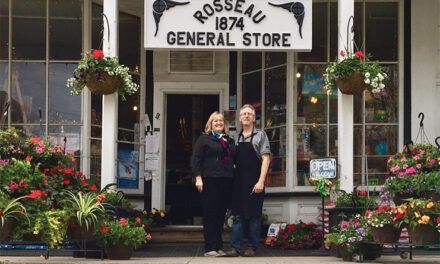
Breakfast Options: Bowls, Pizza, Pastries, Smoothies, Coffee

By Angela Altass
Deciding which breakfast options to offer as part of your foodservice program can depend on various factors.
“For foodservice, it depends on what abilities the store has,” said Dan Glendinning, country manager, Canada foodservice, Hormel Foods International Corporation. “Most items would come from a commissary or industrial meal manufacturer. Hormel Canada foodservice has numerous ingredients from Premoro Toppings to cooked bacon offerings, Hormel Bacon 1 and Hormel Fast ‘N Easy Bacon.”
Breakfast bowls or breakfast pizza are hot items that can be convenient, said Glendinning.

“If a convenience chain has the ability to offer hot ready-to-go items or microwave ready items, these would hit the spot,” said Glendinning. “Many convenience locations are supplied by commissaries, which have the ability to assemble bowls with eggs, potatoes, peppers, onions and sausage or bacon crumbles.”
If ready-to-eat pizza slices are part of the store’s offerings, breakfast pizzas are a great choice and are on trend, said Glendinning.
Consumers are looking for excellent taste and value in their breakfast options, said Raoul Dexters, general manager, of Vandemoortele North America.
Dexters notes that Vandemoortele’s Bake ‘Up freezer-to-oven products are ideal for the convenience market because the amount of labour required to serve fresh pastries is much less than products requiring thawing and proofing.
“They also require significantly less storage space than a non-Bake ‘Up frozen product, saving costs in packaging and storage,” said Dexters. “Our Banquet d’Or pastries are perfect hand-held items for a quick, on-the-go breakfast.”
Breakfast-on-the-go comes down to convenience, said Pascal Kriesche, co-founder and CEO, smoodi, a food tech company that created a robotic smart blender that allows convenience stores to offer natural, vegan smoothies with no sugar added and no operator required.

“A great addition to any foodservice breakfast program, smoodi aims to empower health habits and we see that consumers are repeatedly purchasing our fresh and healthy smoothies to kick-start their day,” said Kriesche. “While breakfast sandwiches and pasties certainly serve a purpose, smoodi can help convenience stores to offer a well-balanced breakfast program that caters to all types of guests, including those who demand healthy options.”
Starting the day with a healthy smoothie sets the stage for making healthy options all day long, said Kriesche.
“The term smoothie has been misconstrued in the convenience store space over the years to a sugary drink with a fruit component to it,” commented Kriesche. “At smoodi, we are setting out to change that. Our research suggests that consumers are demanding smoothies that not only taste great but provide nutritional benefits as well. We allow consumers to enjoy a premium, fresh smoothie in less than a minute.”
Coffee remains an important part of the breakfast experience of many Canadians.
“Not even covid-19 could stop Canadians from drinking coffee,” stated Cheryl Hung, vice president, research, Dig Insights, at the recent Coffee Association of Canada 2022 conference in Toronto.
Hung informed conference delegates of the results of the association’s annual Canadian Coffee Drinking Trends Study.
“This is our third covid year conducting the study and this time round we only did it for two months,” said Hung. “In 2020 and 2021, we did monthly tracking.”
Traditional coffee consumption went up this year, said Hung.
“In these inflationary times, consumers recognize that there is a way to still get coffee but perhaps less expensive coffee,” noted Hung. “Espresso based beverages tend to be more treat-based. Fifty-two per cent of Canadians had a traditional cup of coffee yesterday, which is slightly up, but that doesn’t mean that suddenly there’s an influx of people all going towards traditional coffee, foregoing their lattes and cappuccinos. It just basically means that the industry cup for cup in Canada is split in half. American data is skewed a little bit more at 60 per cent towards specialty and 40 per cent traditional.”
In October 2022, 28 per cent of Canadians had a coffee yesterday out of home, compared to 40 per cent pre-pandemic, said Hung.
“Many people have adopted a hybrid work schedule,” noted Hung. “The hybrid schedule has pulsed back up, but the broader conversation is if people continue to work from home we can expect that the out-of-home number likely will not recover to the 40 per cent figure we saw pre-COVID.”
Even before the pandemic, consumption of traditional coffee out of the home was starting to decline, stated Vince Sgabellone, director, client development, the NPD Group, who also spoke as part of a Seize the Data panel at the Coffee Association of Canada conference.
“We were seeing a drop prior to the pandemic, which was accelerated and exasperated by everything that took place during COVID, so we’re probably not going to get back to where we were pre-COVID for out of home consumption, but we probably weren’t going to be there anyway,” said Sgabellone.
Coffee does remain the number one product consumed in Canadian foodservice and traditional coffee is the number one item, said Sgabellone.
“Traditional coffee still represents two-thirds of all out of home coffees but it’s diminishing because we’re seeing a rise in specialty coffees,” said Sgabellone. “Specialty coffee is really a young person’s drink. Gen Z is coming into their earning years and they love specialty coffees. Two-thirds of their coffee consumption is a specialty preparation versus their parents and grandparents who grew up with traditional coffee.”
There are changes taking place in where coffee is being consumed, said Sgabellone.
“Twenty-four per cent of all coffee purchased out of the home is consumed in the home,” noted Sgabellone. “People go out and buy the coffee and bring it back home and consume it there. One-third of all out of home coffee is being consumed in the car. As we resume our out of home lifestyles, running errands, visiting friends, going to work, dropping kids off at events, we’re drinking more coffee in the car than we ever used to. Meanwhile, what is declining is consumption at work. We’re just not at work as often so that work portion of out of home coffee consumption is way down to 12 per cent.”
Drinking coffee at a restaurant when you’re having breakfast or snacking is down to 22 per cent. Carry out is starting to come back as more people go back to work but is still down compared to 2019.




































